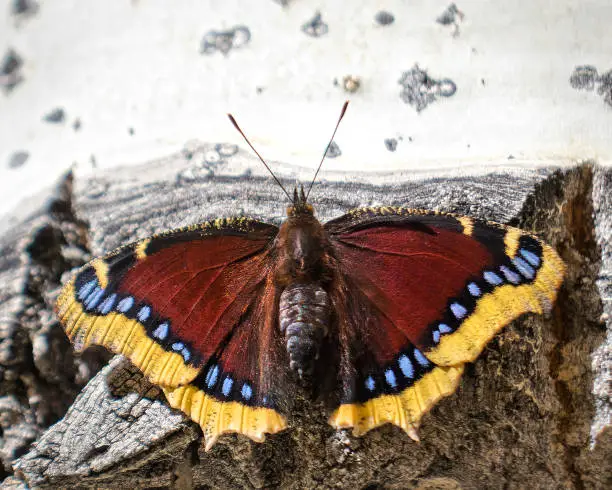“Butterflies are God’s confetti, thrown upon the Earth in celebration of His love.” — K. D’Angelo
The Mourning Cloak Butterfly, scientifically known as Nymphalis antiopa, is a fascinating and visually striking insect. Recognizable by its deep maroon wings edged with pale yellow, this butterfly holds significant meaning in various cultures. In this article, we venture into a bewitching journey about the myriad aspects of the Mourning Cloak Butterfly, exploring its symbolism, appearance, habitat, and more.
Mourning Cloak Butterfly Meaning
“To me, a butterfly is proof that you can go through a great deal of darkness yet become something beautiful.” — Anonymous
The name “Mourning Cloak” is evocative, suggesting a sense of melancholy or loss. This butterfly is often associated with transitions and transformations, embodying the unpropitious themes of mourning and rebirth.
Its dark, cloaked appearance adds to its symbolic sonority, often seen as a representation of the soul’s journey through grief towards healing.
What Does It Mean (Spiritually) When You See a Mourning Cloak Butterfly?
“The butterfly is a symbol of transformation. It reminds us that change is a beautiful thing.” — Anonymous
Seeing a Mourning Cloak Butterfly can be a powerful experience. In many cultures, the appearance of this butterfly is seen as a sign of a loved one watching over you.
It is believed to bring messages from the spiritual realm, offering comfort and reassurance. Some interpret its presence as a prompt to embrace change and personal growth.
Spiritually, the Mourning Cloak Butterfly is often seen as a messenger from the afterlife. Its appearance can signify that a departed loved one is near, offering protection and guidance. It also encourages individuals to embrace spiritual growth and the ongoing process of personal evolution.
What Does a Mourning Cloak Butterfly Look Like?
“Butterflies are not insects; they are self-propelled flowers.” — Robert A. Heinlein
The Mourning Cloak Butterfly is easily identifiable by its unique coloration. Its wings are a rich, velvety maroon bordered with a band of pale yellow and dotted with blue spots. The underside of its wings is darker, providing effective camouflage.
With a wingspan ranging from 2.5 to 4 inches (10.16 cm), it’s one of the larger butterflies found in North America.
Are Mourning Cloak Butterflies Rare?
“Butterflies… flowers that fly and all but sing.” — Robert Frost
Mourning Cloak Butterflies are relatively common, particularly in temperate regions across North America, Europe, and Asia. They are not considered rare, but their presence can vary with local environmental conditions and seasonal changes.
Are Mourning Cloak Butterflies Poisonous?
“Butterflies are the embodiment of a moment, of beauty and frailty, of life and death, all encapsulated in a delicate, fluttering form.” — Anonymous
Despite their striking appearance, Mourning Cloak Butterflies are not poisonous. They pose no threat to humans or pets and can be admired without concern for toxicity. Their caterpillars, however, have spiny hairs that can cause mild skin irritation if handled incorrectly.
Mourning Cloak Butterfly Symbolism
“Butterflies are the gentle giants of the insect world.” — Anonymous
Symbolically, the Mourning Cloak Butterfly is rich with meaning. It represents endurance, survival, and the beauty which can emerge from adversity. Its lifecycle, emerging from a cocoon after winter, mirrors the human journey through difficult times to renewal and transformation.
Beyond its general symbolism of transformation and rebirth, the Mourning Cloak Butterfly also symbolizes resilience and adaptability. Its ability to endure harsh winters and emerge in spring is a testament to its strength and perseverance, qualities that resonate deeply in symbolic terms.
What Do Mourning Cloak Butterflies Eat?
“Butterflies are like dreams. They appear to be fragile, but they are capable of great things.” — Anonymous
Mourning Cloak Butterflies have a varied diet. As adults, they feed on tree sap, rotting fruit, and nectar from flowers. Their caterpillars primarily feed on the leaves of willow, elm, and poplar trees. This diverse diet helps them thrive in various environments; including forests, parks, gardens, and areas near water bodies like streams and ponds. They prefer temperate climates and are well-adapted to both urban and rural settings.
Where Do Mourning Cloak Butterflies Live?
“Butterflies are nature’s art, always adding color and beauty to the world.” — Anonymous
These butterflies are highly adaptable and can be found in a range of habitats, including forests, parks, gardens, and along streams. They are widespread across North America, Europe, and Asia, favoring temperate climates.
Mourning Cloak Butterfly Significance
“The butterfly teaches us that struggles are necessary for growth and transformation.” — Anonymous
The Mourning Cloak Butterfly holds significant ecological and cultural importance. Ecologically, they play a role in pollination and serve as a food source for other wildlife. Culturally, their unique appearance and lifecycle have made them a symbol of transformation and resilience in various traditions.
Mourning Cloak Black Butterfly with Yellow Edges Meaning
“Butterflies are proof that a little change can make a big difference.” — Anonymous
The specific coloration of the Mourning Cloak Butterfly – black with yellow edges – enhances its symbolic meaning. The dark wings symbolize the depths of grief and mourning, while the bright yellow border represents hope and the emergence of new beginnings.
Mourning Cloak Butterfly Life Cycle
“Butterflies are living proof that endings are just new beginnings in disguise.” — Anonymous
The life cycle of the Mourning Cloak Butterfly is a remarkable process. It begins with eggs laid on host plants. The larvae (caterpillars) hatch and feed voraciously before pupating. The adult butterfly emerges from the chrysalis, often after hibernating through winter, ready to continue the cycle of life.
Mourning Cloak Meaning
“Butterflies remind us to embrace change with grace and acceptance.” — Anonymous
The term “mourning cloak” reflects the butterfly’s somber yet striking appearance. It symbolizes the duality of life and death, grief and hope. This duality is central to its meaning, representing the beauty that can arise from the depths of sorrow.
Conclusion
The Mourning Cloak Butterfly is a remarkable creature, rich in symbolism and ecological significance. Whether seen as a spiritual messenger, a symbol of resilience, or simply a beautiful part of nature, this butterfly captures the imagination and hearts of those who encounter it. Through understanding its meaning, appearance, and life cycle, we gain deeper appreciation for the natural world and the lessons it offers.
“Butterflies are the embodiment of the phrase ‘beauty in imperfection’.” — Anonymous

